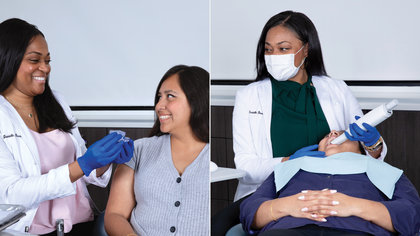2201 Dupont Dr., Irvine, CA 92612
© 2025 Glidewell. All rights reserved.
800-854-7256 USA
Glidewell R&D shows how new dental technology can be a model for other industries.


In a nondescript warehouse on an Irvine, California, street named for one of history’s preeminent rocket scientists, David Leeson and his team are taking dentistry where it’s never been before. While Glidewell has long been a trailblazer in the area of dental research and development, some of its most recent innovations in dental technology have drawn attention from renowned manufacturers beyond dentistry. Fellow innovators know bold new applications of technology when they see them.
Leeson, vice president of engineering at Glidewell, played an integral role in developing Glidewell Intelligent Manufacturing (IM), the company’s new, fully automated workflow that is available for BruxZir® Zirconia. The workflow is imbued with artificial intelligence, machine learning, micro-CT scanning and other cutting-edge dental technologies.

For some, it’s hard to fathom that these modern tools are being employed in an industry still significantly reliant on stone models and other analog tools. But the facts are nevertheless quite clear: The Glidewell Research & Development department is making dentistry a driver for intelligent dental technology and manufacturing, at a time when digital dentistry is all the more important for dental teams’ safety.
As a result, Leeson is an extraordinarily busy man. Just a glance at his calendar reveals the astonishing demand for his time and insight. In the span of one week, Leeson has:
These requests are compliments. They are the spoils of excellence and the result of Glidewell’s lengthy and remarkable history of achievements in researching and developing new dental technology. It’s even more remarkable given that Leeson’s background is not in dentistry but in motorsports. The thread that binds together these two vastly different areas of focus is a design concept Leeson calls “mass customization.”
"Because it’s very, very expensive to make small runs of engines for race cars, every project was concept-to-production, designing something completely new to order,” Leeson said. “To do that in an economical way, we thought we were really clever to produce 50 engines here, 10 engines there, and so on. But when Glidewell started talking about mass customization, I realized it was on a completely different scale than anything I’d experienced."
Speaking specifically of Glidewell IM, Leeson said the process enables Glidewell to fabricate better restorations faster and more accurately than the conventional approach (e.g., laboratory technicians handling a restoration at each phase of manufacturing).
Glidewell IM represents a radical departure from conventional restorative dentistry protocols. Its “closed loop” manufacturing system means there isn’t a human being on the end of a production line eyeballing a dental restoration on a stone model. Instead, Glidewell IM uses article scanners that generate a three-dimensional geometric model of the finished restoration and intelligently provide a pass/fail determination based on exacting standards established by Glidewell. This production process has many benefits, including the following:
"At first glance, the products we make might not strike someone as having a ‘cool’ factor. But the way we make them is really cool and cutting-edge,” Leeson said. “Constant innovation is necessary so we can continue to make dentists’ lives easier."
Indeed, it is, which leads to a natural question: What’s next?
"Most of what we have in Glidewell IM today is about consistency and dimensional precision,” Leeson said. “The next phase is about esthetics. As it stands now, a dentist is picking from one of 16 de facto shades. We’d like to improve on that process and make it faster for the dentist. That’s where I see a lot of our work going in the next few years."
Send blog-related questions and suggestions to hello@glidewell.com.



